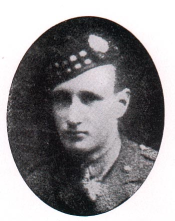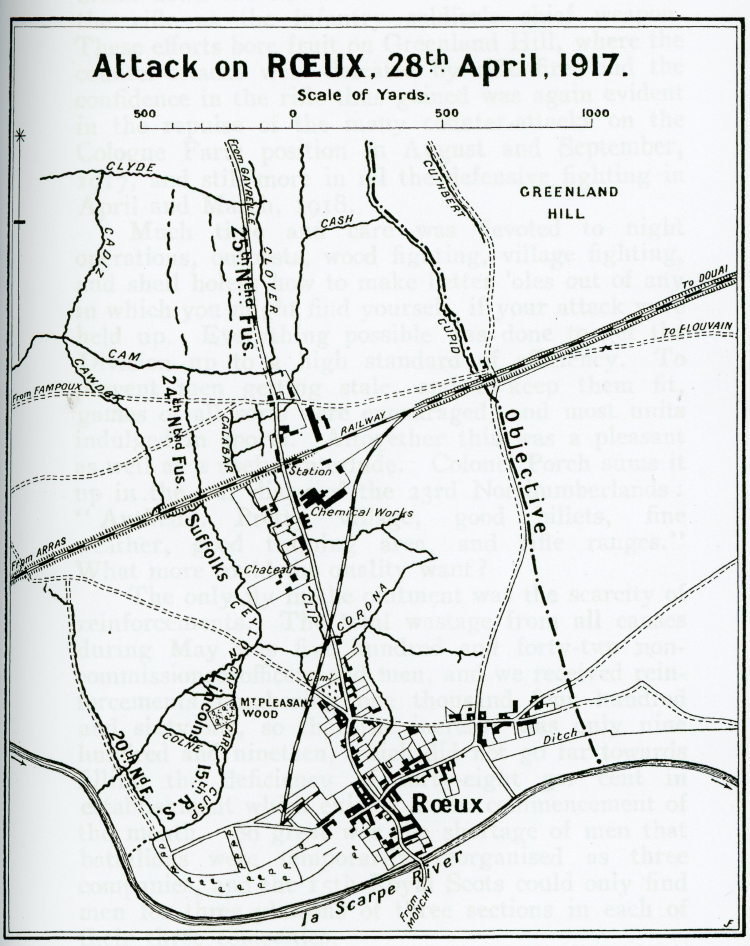2nd Lieutenant William Murray Masterton
 6th Battalion (T)
6th Battalion (T)
The Royal Scots (Lothian Regiment)
attached 16th
died of wounds 10th June 1917
aged 19
Duisans British Cemetery, Etrun
son of James Masterton and Bessie Todd Murray, Edinburgh
Genealogy
William Murray Masterton was born at 10 Royston Terrace, Edinburgh, Midlothian, Scotland on 7 May 1898, the elder son of two born to James Masterton, BA, headmaster of Albion Road School, and Bessie Todd Murray. By 1911, the family, including William (12), at school, was living in Canongate, Edinburgh, Midlothian, Scotland. William was educated at George Watson's College in Edinburgh from 1910-12 and then became an actuarial apprentice in the Century Assurance Office until he volunteered when war was declared, joining, initially, the 4th Battalion, The Royal Scots as a Private (200721). Further details of William, his parents and younger brother and the extended family of Mastertons originally from the Forfar area can be found at the following link.
His War
The 1/4th Battalion The Royal Scots (Queen's Edinburgh Rifles) was a Territorial battalion, part of Lothian brigade, Scottish Coast Defences. In April 1915 it was transferred to 156th (Scottish Rifles) Brigade, under orders of 52nd (Lowland) Division. On 24 May 1915, at the age of 17 years and 17 days, well under the minimum legal age of 19 for serving overseas, William sailed with the Division from Liverpool via Egypt to join the Gallipoli campaign, arriving in Egypt on 8th June 1915, and Gallipoli on 14 June 1915. He was fortunate to survive that. 156 Brigade was in action leading an attack in the Battle of Krithia on the Helles peninsula on 28 June 1915 and suffered heavy losses. Gallipoli was finally abandoned by the British and French forces in January 1916 and the Division returned to Egypt.
Despite his age, William must have shown promise, and coming from a good school will have helped his case, so he was selected for officer training and sent to Gailes Camp, Ayrshire, Scotland gaining his commission with the 6th Royal Scots on 28th March 1917, which since July 1916 had come under orders of 14th Brigade, 32nd Division. He was 18 years old.
The London Gazette
TERRITORIAL FORCE.
The undermentioned, from Officer Cadet
units, to be 2nd Lts. Dated 28th Mar.
1917: —
INFANTRY.
Royal Scots.- William Christie.
Frank Bell Moffat.
Charles Stirling Dundas Tainsh.
George Forbes Forsyth.
William Murray Masterton.
John Dewar Barren.
David James Cossar.
Lewis Mclver Jobson.
James Gray Reid.
William Rutherford.
William Cunningham Thomson.
Nicholas Smith Craig.
John Morley Stewart.
The London Gazette
10 April 1917
His obituary in the George Watson's memorial record, confirmed in Unit War Diaries, shows that he was later attached to the 16th Battalion, raised in Edinburgh by George McCrae, which drew recruits initially from many football clubs in Scotland. In 1917, it was under orders of the 101st Brigade, 34th Division. William died on 10th June 1917 from wounds received the previous day and was buried in Duisans British Cemetery, Etrun to the north-west of Arras, which served as a place of burial for the 8th, 19th and 41st Casualty Clearing Stations. The 16th Royal Scots was engaged in the latter stages and aftermath of the Battle of Arras.
Its heaviest involvement was in the Attack on Roeux on 28 April 1917, when the 101st Brigade was designated as "moppers up" but, as Lieutenant Leonard Robson, who was captured by the Germans, put it, were effectively "mopped up" themselves by enemy reinforcements from the nearby chemical works. The battalion lost 6 officers and 170 men that day. The survivors would have welcomed the subsequent three weeks in billets in Berneuil for receiving new drafts and training. William joined the battalion there on 22nd May, although he is mis-recorded in the Unit War Diaries as "2/Lt W.M. MASTERMAN". On 30th May, the battalion returned to the front line on the forward slopes of Greenland Hill to the north-east of Roeux. The battalion endured a fortnight of sniping and shelling and lost 21 more men in total. William was wounded on 9 June 1917 as were two other officers and two other ranks. One officer, 2nd Lieutenant George Hamilton, was killed outright. William was reported dead in the following day's Unit War Diary. He had served a total of 19 days with the battalion.

William received his fatal wounds on 9th June
when the battalion was under constant sniping and bombardment in front line trenches on Greenland Hill.
map source: The Thirty Fourth Division 1915 - 1919. John Shakespear.
Unit War Diary: 16th Battalion, The Royal Scots
BILLETS: 22nd May 1917: 8 a.m. Battn made to practise attack formations & advancing under a barrage.
2.30 p.m. Lecture by Catering Officer, 3rd Army, on food economy.
9.15 p.m. Battn. parade for night operations, marching on a compass bearing, deploying & laying out trenches.
The following officers joined & were posted to Companies as follows:
2/Lts G.F. FORSYTH & J.C. BAIRD to 'B' Coy; 2/Lts N.G. HONEYMAN & J.D. BARRON to 'C' Coy, 2/Lt W.M. MASTERMAN (sic) to 'D' Coy.
TRENCHES: 7th June 1917: Our artillery shelled enemy lines very severely in the forenoon and the enemy retaliated on front and support lines. Considerable aerial activity on both sides.
12 O.R. rejoined the Battalion from Hospital etc.
8th June 1917: Severe enemy shelling throughout the day. 5 O.R. killed, 19 O.R. wounded.
9th June 1917: 2nd Lieuts R.W.F. JOHNSTON, P. HARROWER, R. ANDERSON, D.H. BROWN, A.J. SHEDDEN, J. McKENZIE joined the Battn. Lieut. H. RAWSON wounded (out ??) 2nd Lieut W.M. MASTERTON and 2 O.R. wounded.
2nd Lieut G.J. HAMILTON killed. 2nd Lieut R. ANDERSON wounded (shell shock).
10th June 1917: 2nd Lieut W.M. MASTERTON died of wounds. 5 O.R. killed, 8 O.R. wounded.
11th June 1917: Quiet day. 3 O.R. wounded.
National Archives
Kew, London
Unit War Diaries: WO 95/2458/1
34 Division; 101 Brigade; 16 Battalion, The Royal Scots
Jan 1916 - Aug 1918
The Scotsman
MASTERTON:- On 10th inst., of wounds received in battle, Sec. Lieut. W. M. MASTERTON, Royal Scots, elder son of James Masterton, Headmaster, Albion Road School, Edinburgh.
Sec. Lt. W. M. MASTERTON, Royal Scots (died of wounds), was the elder son of Mr James Masterton, headmaster of Albion Road School, EDINBURGH. He was gazetted in March last.
The Scotsman
Edinburgh
12 June 1917
Watson's War Records: George Watson's College
A son of Mr. J. Masterton, B.A., Edin., was born in 1898, and, having attended G.W.. 1910-12, was entered as an actuarial apprentice in the Century Assurance Office. He enlisted in the 4th R.S. in 1914, and served through the Gallipoli campaign. After training at Gailes, he was gazetted to the 6th R.S., then attached to the 16th Bn., and fell on June 10, 1917, aged 19.
Other Sources
- William Murray Masterton Service Record is held in UK National Archives at
WO 374/46695
Description: 2/Lieutenant William Murray MASTERTON The Royal Scots (Lothian Regiment) (not digitised) - Commonwealth War Graves Commission
- Scottish National War Memorial
- William Masterton Medal Roll Index Card
- William Masterton Medal Roll-Victory and War
- William Masterton Medal Roll-1914-15 Star
- William Masterton Medal Roll - Officer
- William Murray Masterton's Deceased Soldier's Effects
- William Murray Masterton in IWM Lives of First World War
- McCrae's Battalion: The Story of the 16th Royal Scots. Jack Alexander. 2003
- The Thirty Fourth Division 1915-1919. Lieut. Colonel John Shakespear.
- Gallipoli: The End of the Myth. Robin Prior. 2009
- Medals: Victory, British War, 1915 Star.